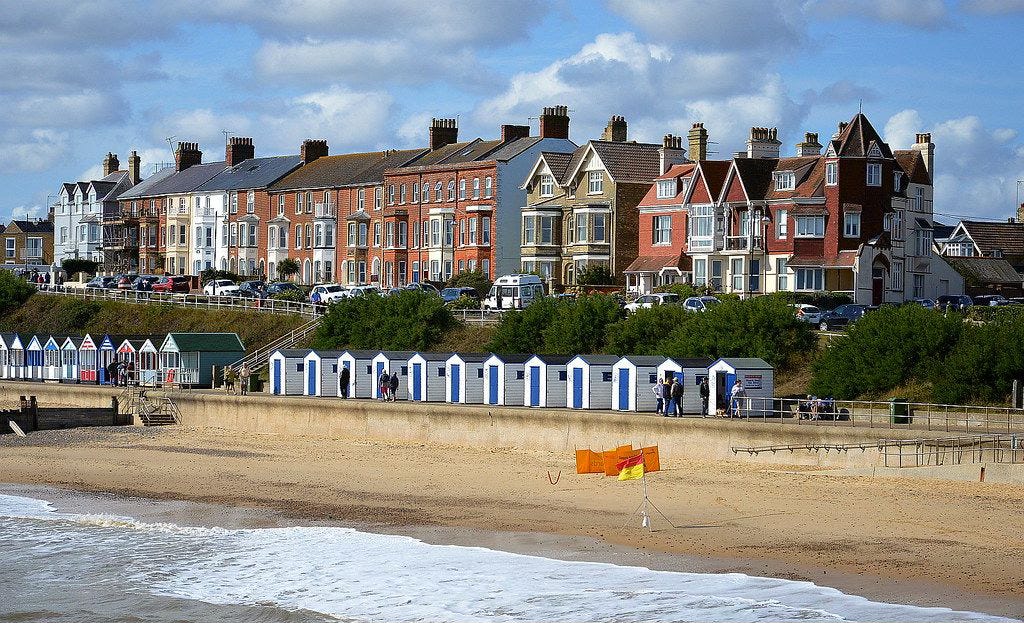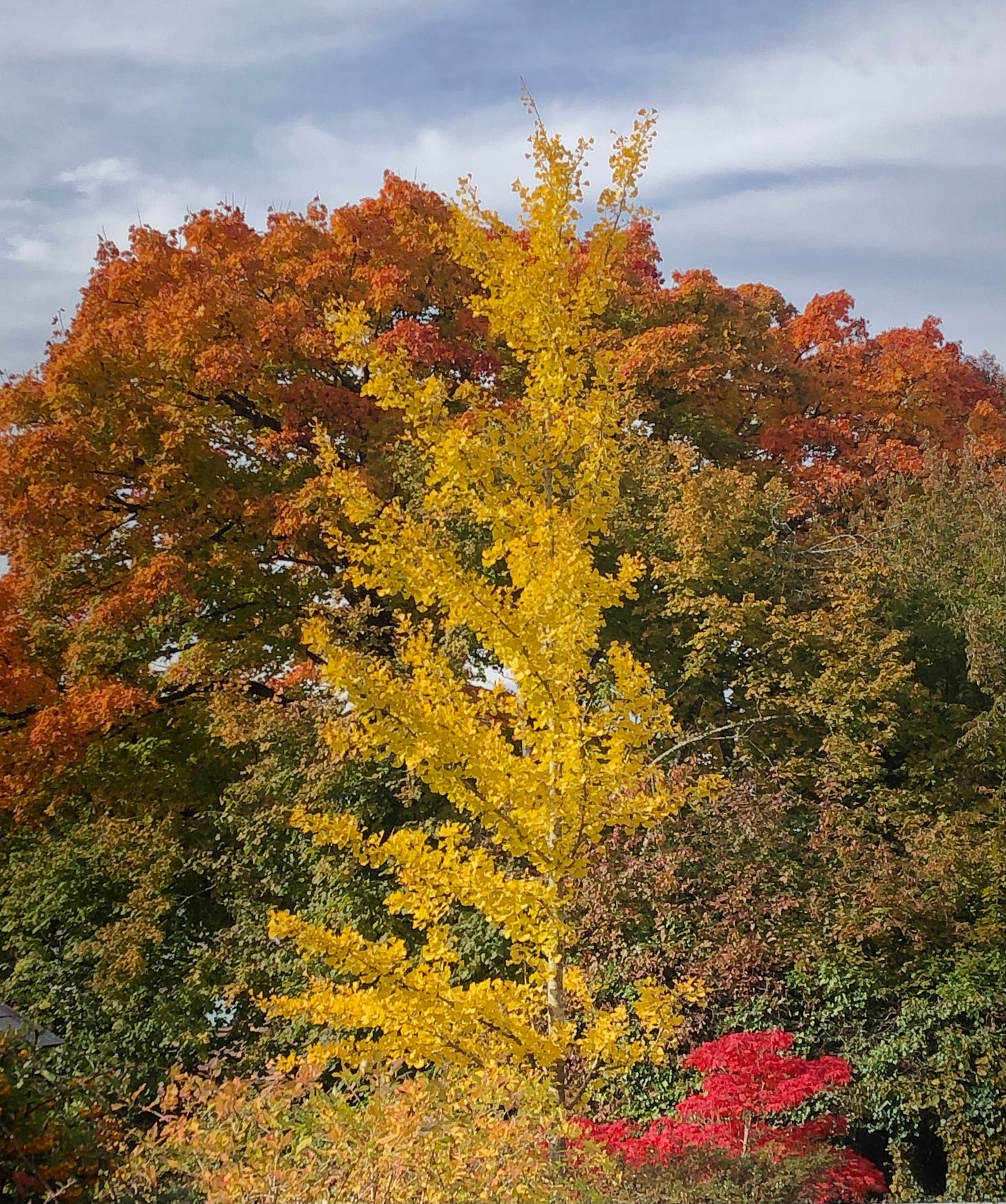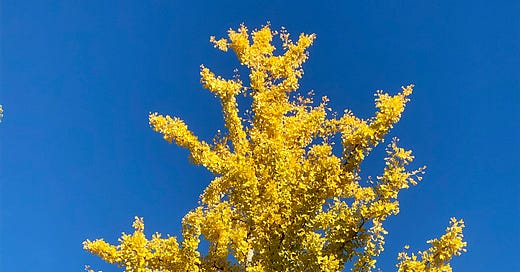According to a recent unofficial, thoroughly unscientific survey, October is everyone’s favorite month. I know it’s mine! I love the crisp, bright days and the excuse to wear my hand-knit sweaters and enjoy hearty dinners. And every October, I am delighted and inspired by ginkgo trees, which are showing off their autumn finery right now:
Glorious, right?
But first:
The Bookshop Book Club
For anyone who hasn’t had time to read the book yet but would like to participate, last week’s post includes biographical information about Penelope Fitzgerald’s time working in a bookshop in a town very like the one in her novel. And here’s what happened in this week’s reading:
It’s 1959 in the aptly-named Hardborough, an insular rural town. Florence Green, a fortyish widow, dreams of opening a bookshop. She purchases the Old House, a rickety, drafty, abandoned building that stinks of rats, is prone to floods, and is infested with a poltergeist. And then Florence begins to receive hints—from Mr Keble, the bank manager; from Miles, whose “fluid personality tested and stole into the weak places of others until it found it could settle down to its own advantage”; and especially from Mrs Gamart, the town’s would-be doyenne of the arts—that actually, the Old House is intended for a cultural center, and wouldn’t Florence rather open her bookshop in Deben’s wet fish shop? As it happens, Florence would rather not. We worry for Florence, who had “blinded herself . . . by pretending for a while that human beings are not divided into exterminators and exterminatees, with the former, at any given moment, predominating.”
Here’s some background about the book’s setting:
Hardborough is based on a real town, Southwold, where Fitzgerald and her family lived from 1958 to 1959. As Fitzgerald’s biographer informs us,1 in 1953, six years before the story opens, Southwold had been devastated by a flood that drowned 378 people and destroyed the countryside; the ocean surge literally salted the earth.
Huddled against its exposed sea- and marsh-scape, the town in the 1950s was inward-looking, parochial and set in its ways. In mist and darkness, wind and cold rain, it could be a strange and gloomy place. Local stories of hauntings and spooky phenomena abounded.

In an interview, Fitzgerald described the town in similar terms:
“[I worked] in a bookshop in a very lonely town we were living in on the east coast in Suffolk, sort of watery and marshy, with Constable skies. . . . I wrote about the shop and about the poltergeist, which was only part of the struggle the bookshop had against the opposition in the town to it being there at all. Not on any rational grounds, but the feeling that reading the kind of book that we sold was sort of putting on airs.”
And here are some possible discussion questions:
Have you ever spent time in a small town like this? Do you think Fitzgerald’s characterization of small-town life is accurate, or is it unjust?
Which characters do you like and sympathize with? How do you feel about Florence?
What might the animals in the story—for example the heron, the eel, and the gelding Florence helps Mr Raven rescue—symbolize?
What do you make of “the rapper”?
Do you have a favorite passage to share?
For next week, let’s read chapters 4–6 (pages 45–86 in my edition). You’ll meet one of my favorite characters in all of literature, Christine Gipping. I’d love to hear what you think of her! And please also keep saving favorite passages to share.
Ginkgo as Metaphor
Despite their autumnal glory, ginkgos are not an unambiguous asset to their communities. Every spring, female ginkgos drop fruits whose smell is variously described as “rancid butter” and “rotting Camembert”—but to me they reek of vomit. The fruit is mildly toxic, and be warned that if you touch one in a foolhardy attempt to extract the nut inside, you may develop a poison-ivy-like rash. The dropped fruits form a slick, stinky paste on the sidewalk. Blech! (For this reason, most ginkgos we see nowadays are male.)
But all is forgiven in the fall, when ginkgos burst out in a stunning golden glow against the muted trees surrounding them.

And then one day, FWOOMP! the ginkgo drops all its leaves at once, to carpet the ground in vivid yellow.

Here are some fun facts2 about ginkgos:
Ginkgos are one of the oldest species of trees in the world. The first ginkgo fossils date back 200 million years. Dinosaurs munched on ginkgo leaves.
Ginkgo trees are extraordinarily long-lived, sometimes as much as 1000 years. There is a ginkgo in China that is said to be 3500 years old; the oldest officially documented ginkgo is 1400 years old.
Ginkgos are incredibly hardy. They were the first trees to begin growing again in Hiroshima after the bombing, and six ginkgos actually survived the blast and are alive to this day.
Ginkgos are also widespread: Fossilized ginkgo leaves have been found on every continent, and ginkgos currently grow in nearly every temperate climate. They are resistant to pollution, so they thrive on city streets.
I find ginkgos inspiring. Yes, sometimes they make a great big mess, and every year they reach a breaking point where they can’t take it anymore and just let go of everything. Stinking up the place now and then and occasionally breaking down in order to renew themselves later on—that’s a fine survival strategy! Ginkgos are useful, resilient, and gorgeous. We could learn a lot from them!
And Now . . . THE LARCH
Speaking of trees that get weird in the fall, I couldn’t resist a brief digression about the larch. One fall day I was out hiking when I saw some—to my mind—very strange trees. They appeared to be conifers, but of a type that was a confused fusion with deciduous trees, because their needles had turned bright yellow and were falling to the ground.
What the heck was going on with these trees? Turns out that the larch is a deciduous conifer and is highly successful in northern climates. As They Might Be Giants informs us, the larch is one of the five hundred types of conifers, my kind of trees:
So the larch is a metaphor too. We are all unique, and maybe we don’t fit into standard categories or live our lives the way everyone else does. That’s ok! The larch does quite well for itself just the way it is, and we do too!
How about you, readers? Have you ever had a ginkgo moment of falling apart with great fanfare and beauty? Or are you more of a larch, defying expectations and shining brightly when everyone around you is staid and sober? Please share your thoughts in the comments!
The Tidbit
In the video below, Patti LuPone goes magnificently to pieces, just like ginkgos this time of year. The song starts out as a sardonic satire of “ladies who lunch,” but the more LuPone sings, the more she realizes that their lives, and her life too, are empty. The song crescendos to a final cry of stunning power, rage, and grief. As a commenter says, “She can scream and spill and breakdown on stage, sing it beautifully, and end up demanding the audience’s applause, for a full minute.” Listen to the end to hear the audience’s raucous and well-deserved ovation.
All facts come from Hermione Lee, Penelope Fitzgerald: A Life (Knopf, 2015). The quotations appear on pages 125 and 130–31.






Thanks for this. My elderly mum is about to move from her home of nearly 60 years to an apartment by the sea and seems to mostly be concerned about whether her potted Gingko will take to its new living quarters. I'm encouraged by you reports about their hardiness and will report back to her!
Personally, I think I'm more of a larch person myself, mostly because I absolutely love their new growth in spring, all soft and green.
Lewis accuses me of paying too much attention to plot. I'm distracted by the improbable setup that Mrs Gamart was not able to intervene in the initial sale and setup of shop enough to stop it before it was a done deal. As Florence says, it took six months to do and there's no way she couldn't have known. This makes me feel like Mrs Gamart willfully allowed the shop to get set up, just so that she could destroy it. Florence doesn't stand a chance, and for me this moves the tone from "sad and pathetic" to downright cruel.